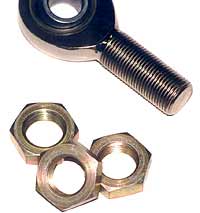
So how can you tell if a bearing is a high
quality piece or not? From two feet away, it's
tough to tell the far eastern sweat-shop jobs
from the genuine article. Here's the secret:
Look at a rod end the same way as you'd look
at any precision component. Inspect the machine
work. Is the surface on the race rough or smooth?
The same with the ball: Is it well machined
and smooth? If the rod end is a non-Teflon configuration,
does the ball fit inside the body precisely
or does it rattle or bind? When looking at a
Teflon bearing, are there gaps in the Teflon
liner or are there areas where the liner is
actually loose? Basically, a Teflon lined rod
end should be one continuous tightly bonded
piece. As you can see, there are a number of
clues as to what constitutes a quality bearing
and what makes up junk.
In the end, the best rod ends are those that
are designed and constructed through proper
engineering and backed by a rigorous R&D program.
In the real world, the rod end you're searching
for should feature precision ground steel balls
and it must constructed with the highest quality
materials. If you don't take this approach,
the only person you'll be fooling is yourself.
Quality costs money. This is no place to get
cheap.
 Both
of these Aurora rod ends have 3/4-inch shanks.
The rod end on the left (threaded into the trailing
arm) is a standard model, while the rod end
on the right is a heavy duty model. What's the
difference? The HD model has a 5/8-inch bore
while the standard version has a 3/4-inch bore.
In construction, an oversize shank is generally
made by installing an insert one size smaller
in the body of the part with the larger shank.
Because of this, a 5/8-inch X 3/4-inch rod end
will exhibit higher load capacities than a 3/4-inch
X 3/4-inch rod end, provided both are manufactured
from similar materials. There is one exception
to the above oversize shank construction rule:
Some companies offer a rod end where a larger
shank is added to a smaller body. While this
configuration serves the same purpose as the
oversize shank, it provides less meat around
the rod end ball (simply because there's less
material surrounding the spherical bearing). Both
of these Aurora rod ends have 3/4-inch shanks.
The rod end on the left (threaded into the trailing
arm) is a standard model, while the rod end
on the right is a heavy duty model. What's the
difference? The HD model has a 5/8-inch bore
while the standard version has a 3/4-inch bore.
In construction, an oversize shank is generally
made by installing an insert one size smaller
in the body of the part with the larger shank.
Because of this, a 5/8-inch X 3/4-inch rod end
will exhibit higher load capacities than a 3/4-inch
X 3/4-inch rod end, provided both are manufactured
from similar materials. There is one exception
to the above oversize shank construction rule:
Some companies offer a rod end where a larger
shank is added to a smaller body. While this
configuration serves the same purpose as the
oversize shank, it provides less meat around
the rod end ball (simply because there's less
material surrounding the spherical bearing).

Just to give you an example of rod end use,
have a look at this fabricated trailing arm.
This particular example is constructed from
1-1/4 X 0.095-inch chrome moly tubing, uses
two different types of welded tubing adapters
incorporates high quality jam nuts.
 As
mentioned in the text, be very careful when
purchasing jam nuts. They're not all created
equal either. Like inferior rod ends, some of
this stuff is absolute junk. These particular
jam nuts are from Mark Williams Enterprises
and are definitely the highest of quality. Another
option is to use aircraft hardware. As
mentioned in the text, be very careful when
purchasing jam nuts. They're not all created
equal either. Like inferior rod ends, some of
this stuff is absolute junk. These particular
jam nuts are from Mark Williams Enterprises
and are definitely the highest of quality. Another
option is to use aircraft hardware.
| Sources |
|
Aurora Bearing Company
970 S. Lake Street
Aurora, IL 60506
PH: 630-859-2030
|
Jerry Bickel Race
Cars
141 Raceway Park Drive
Moscow Mills, MO 63362
PH# 636-356-4727
|
|